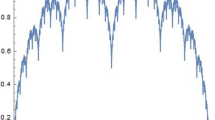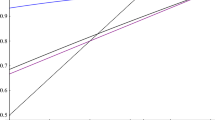Abstract
It is well known that there are planar sets of Hausdorff dimension greater than 1 which are graphs of functions, i.e., all their vertical fibres consist of 1 point. We show this phenomenon does not occur for sets constructed in a certain “regular” fashion. Specifically, we consider sets obtained by partitioning a square into 4 subsquares, discarding 1 of them and repeating this on each of the 3 remaining squares, etc.; then almost all vertical fibres of a set so obtained have Hausdorff dimension at least 1/2. Sharp bounds on the dimensions of sets of exceptional fibres are presented.
Similar content being viewed by others
References
K. B. Athreya and P. E. Ney,Branching Processes, Springer-Verlag, New York, 1972.
P. Billingsley,Ergodic Theory and Information, Wiley, New York, 1965.
I. Benjamini and Y. Peres,Random walks on a tree and capacity in the interval, preprint.
H. Cajar,Billingsley dimension in probability spaces, Springer Lecture Notes in Math.892, Springer-Verlag, New York, 1981.
L. Carleson,Selected Problems on Exceptional Sets, Van Nostrand Mathematical Studies #13, 1967.
F. M. Dekking and C. R. Grimmett,Superbranching processes and projection of random Cantor sets, Probability Theory and Related Fields78 (1988), 335–355.
K. J. Falconer,Projections of random Cantor sets, Journal of Theoretical Probability1(1) (1989).
H. Furstenberg,Disjointness in ergodic theory, minimal sets, and a problem in Diophantine approximation, Math. Systems Theory1 (1967), 1–49.
H. Furstenberg,Intersections of Cantor sets and transversality of semigroups, inProblems in Analysis, A Symposium in Honor of S. Bochner (R. C. Gunning, Ed.), Princeton University Press, 1970, pp. 41–59.
R. Kenyon and Y. Peres,Intersecting random translates of invariant Cantor sets, preprint.
R. Lyons,Random walk and percolation on trees, Ann. Probab., to appear.
J. M. Marstrand,Some fundamental geometrical properties of plane sets of fractional dimension, Proc. London Math. Soc. (3)4 (1954), 257–302.
P. Mattila,Hausdorff dimension and capacities of intersections of sets in n-space, Acta Math.152 (1984), 77–105.
R. D. Mauldin and S. C. Williams,Random recursive constructions: asymptotic geometric and topological properties, Trans. Am. Math. Soc.295 (1986), 325–346.
L. S. Young,Dimension, entropy, and Lyapunov exponents, Ergodic Theory and Dynamical Systems2 (1982), 109–124.
Author information
Authors and Affiliations
Additional information
Partially supported by a grant from the Landau Centre for Mathematical Analysis.
Rights and permissions
About this article
Cite this article
Bejamini, I., Peres, Y. On the Hausdorff dimension of fibres. Israel J. Math. 74, 267–279 (1991). https://doi.org/10.1007/BF02775791
Received:
Issue Date:
DOI: https://doi.org/10.1007/BF02775791




